Sarah Sundin's Blog, page 334
July 31, 2015
Through Waters Deep – Tour of Boston, Part 5 – plus giveaway!
 The city of Boston is fascinating—chockfull of history and color. While best known for its key role in the American Revolution, the city also played a role in World War II, with busy shipyards and naval bases—and more! The city’s reputation for revolutionary foment seemed a great backdrop for Through Waters Deep, set in the tumult of 1941, as isolationists and interventionists argued the correct course for the nation’s future, and as rumors of sabotage and espionage ran rampant.
The city of Boston is fascinating—chockfull of history and color. While best known for its key role in the American Revolution, the city also played a role in World War II, with busy shipyards and naval bases—and more! The city’s reputation for revolutionary foment seemed a great backdrop for Through Waters Deep, set in the tumult of 1941, as isolationists and interventionists argued the correct course for the nation’s future, and as rumors of sabotage and espionage ran rampant.
To enter the giveaway for Through Waters Deep, see the information at the end of the post.
I’ve been blessed to visit Boston a number of times. In July 2014, I made a research trip and took lots of pictures to help me visualize the story. We’ve followed the Freedom Trail, established in the 1950s to connect Boston’s multiple historical sites. Earlier we explored:
Boston Common and the Public Garden
Paul Revere House and Old North Church
Charlestown and the USS Constitution
Today we visit the Charlestown Navy Yard, originally known as the Boston Navy Yard. Founded in 1800, the Navy Yard became a major site for construction and repair of US naval warships. The Yard closed in 1973, but was incorporated into the Boston National Historical Park in 1974, and is now a popular tourist site.
Let’s follow the path of my fictional heroine in Through Waters Deep, Mary Stirling, as she goes to work. Entering the gate at the intersection of Chelsea and Tremont, we first pass the Ropewalk, built in 1837. Workers in this extremely long narrow building could fashion rope up to 1200-ft long. The ropewalk produced all manila line for the United States Navy until 1955. Just past the ropewalk stands the octagonal Muster House, built in the 1850s.
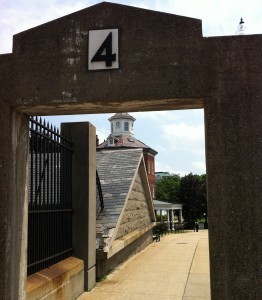
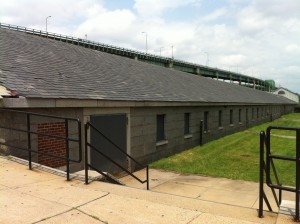
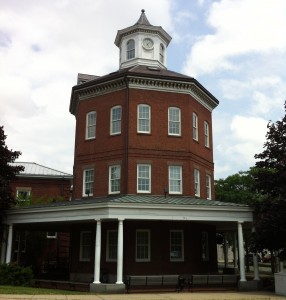
Heading to the northeast along Second Avenue, we enter a large cluster of buildings used for everything from offices to workshops to storage to forges. No longer part of the Navy Yard, these buildings are being converted to civilian use. Mary works in a fictional office in Building 39.
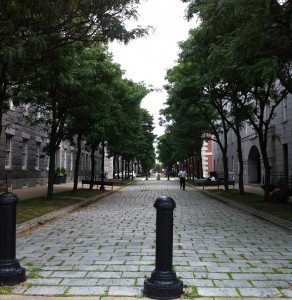
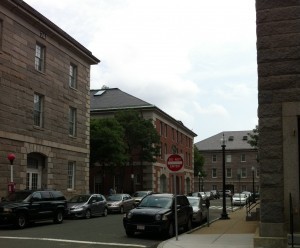
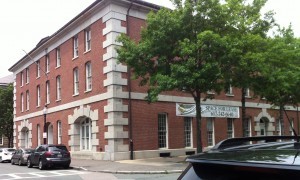
Ships at the Boston Navy Yard were constructed in two different methods. Ships could be constructed on shipways, with above-ground scaffolding, and launched “down the ways” into Boston Harbor. Ships could also be constructed in dry docks, large basins with a caisson at the end to keep the seawater out. To launch the ship, water was pumped through the caisson into the dry dock to float the ship. Then the caisson was removed, and the ship sailed out. Alternately, a ship could pull in to a flooded dry dock for repairs. The caisson was positioned, and water was pumped out. This was done on 17 May 2015 at the Charlestown Navy Yard for the restoration of USS Constitution. You can see a fun time-lapse video of the process here. Dry Dock 1 was constructed in 1833, and Dry Dock 2 in 1905. More were added later.
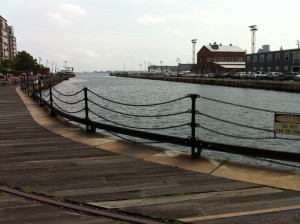
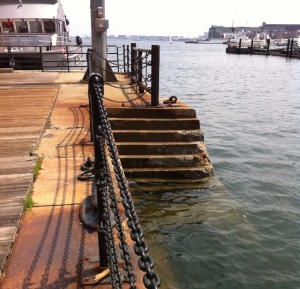
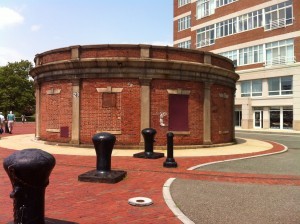
The Charlestown Navy Yard was responsible for the construction and repair of thousands of ships. From 1939-45, six thousand ships were constructed, repaired, or outfitted. At the start of World War II, women worked at the Navy Yard only as telephone operators or in clerical positions (like Mary). As the war progressed, women were hired for more types of jobs. At the peak in 1943, the Boston Navy Yard employed 50,000 people, 20 percent of whom were women.

Today the Charlestown Navy Yard is an essential stop for the Boston tourist. The USS Constitution, flagship of the US Navy, has called Boston her home port since 1897 (see my post here), and the World War II era destroyer USS Cassin Young has been docked there since 1978 (see my post coming August 3). Both the Charlestown Navy Yard Visitor Center and the USS Constitution Museum are well worth a visit, especially with children. For fun, take the ferry from downtown Boston to the Navy Yard!
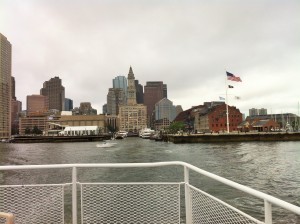
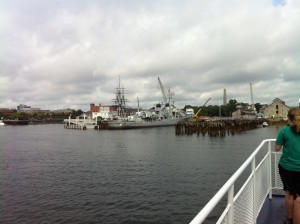
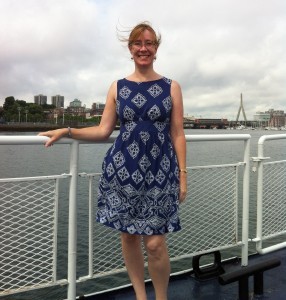
Sources:
Boston National Historical Park, Charlestown Navy Yard: http://www.nps.gov/bost/learn/historyculture/cny.htm
Bither, Barbara A., Boston National Historical Park. Images of America: Charlestown Navy Yard. Charleston, SC: Arcadia Publishing, 1999.
Boston National Historical Park. Charlestown Navy Yard. Washington, DC: Division of Publications, National Park Service, U.S. Department of the Interior, 2010.
 Giveaway
GiveawayI’m giving away this adorable vintage Through Waters Deep apron, made by my talented author-buddy Marci Seither, and modeled by her lovely daughter! To enter, leave a comment below (US & Canada only please), or on next week’s Destroyer Tour posts, which will show pictures from World War II destroyers, as in the novel. You can earn a maximum of three entries by leaving a comment on each of the three posts. If you can’t leave a comment, please send me an email to enter. Giveaway ends Wednesday, August 5, 2015 at midnight, Pacific Time. I’ll announce the winner here on Friday, August 7, 2015.
Today in World War II History—July 31, 1940 & 1945
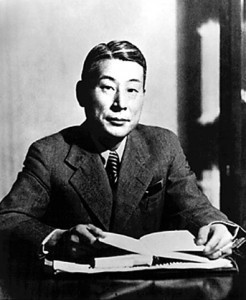
Chiune Sugihara (Japanese government photo)
75 Years Ago—July 31, 1940: In Lithuania, Japanese Consul Chiune Sugihara begins writing thousands of visas for Jews to flee through the USSR into Japanese-controlled China. First Mitsubishi Zero is delivered to the Japanese navy.
70 Years Ago—July 31, 1945: Former head of Vichy French government, Pierre Laval, is sent from Spain to Austria under pressure from France; he is immediately arrested by the Americans and turned over to the French. He will be executed October 15 for collaborating with the Nazis.
July 30, 2015
Today in World War II History—July 30, 1940 & 1945
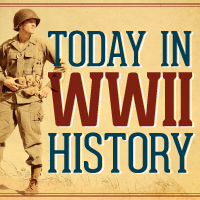 75 Years Ago—July 30, 1940: Act of Havana is signed by the US and twenty Latin American countries, agreeing to help any country threatened by the Axis in the Americas.
75 Years Ago—July 30, 1940: Act of Havana is signed by the US and twenty Latin American countries, agreeing to help any country threatened by the Axis in the Americas.
70 Years Ago—July 30, 1945: Japanese make final stand in New Guinea, at Numbogua.
July 29, 2015
Through Waters Deep – Tour of Boston, Part 4 – and Giveaway Winners

See below for Through Waters Deep book giveaway winners!
The city of Boston is fascinating—chockfull of history and color. While best known for its key role in the American Revolution, the city also played a role in World War II, with busy shipyards and naval bases—and more! The city’s reputation for revolutionary foment seemed a great backdrop for Through Waters Deep, set in the tumult of 1941, as isolationists and interventionists argued the correct course for the nation’s future, and as rumors of sabotage and espionage ran rampant.
I’ve been blessed to visit Boston a number of times. In July 2014, I made a research trip and took lots of pictures to help me visualize the story. We’ll follow the Freedom Trail, established in the 1950s to connect Boston’s multiple historical sites. Join us as we explore:
Boston Common and the Public Garden
Paul Revere House and Old North Church
Charlestown Navy Yard (coming 7/31)
Today we cross the Charles River from downtown Boston to visit Charlestown and the USS Constitution. Settled by the Puritans in 1628, the city was incorporated in 1847 and annexed to the City of Boston in 1874, making it a neighborhood. Charlestown is most famous as the site of the Battle of Bunker Hill and for the Charlestown Navy Yard, home of the USS Constitution and the WWII destroyer USS Cassin Young. The next post in this Tour of Boston series will look at the Navy Yard, and next week I’ll show pictures from the Cassin Young and other destroyers.
At the base of the Charlestown Bridge lies City Square, the location of a park and shops, and the former location of an “El” station. Just off City Square at the corner of Main and Henley lies my fictional Dixon’s Drugs, a store that will be featured in the second book in the series, Anchor in the Storm.
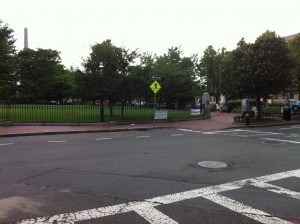
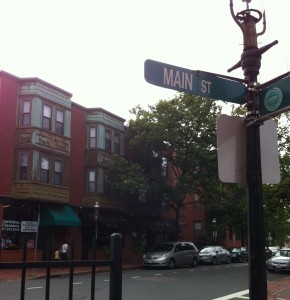
Monument Avenue leads from Main Street up Breed’s Hill to the Bunker Hill Monument. This lovely linden-tree lined avenue is where I chose to place Mary Stirling’s apartment in the book.
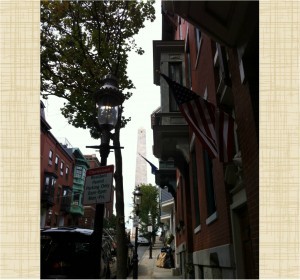
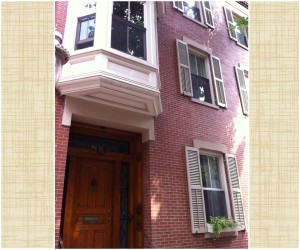
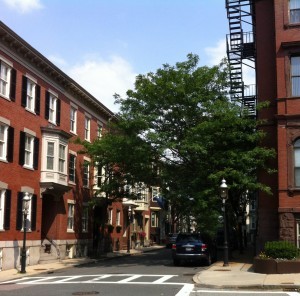
At the top of Breed’s Hill sits the Bunker Hill Monument, built in 1842 to commemorate the Battle of Bunker Hill. On 17 June 1775, the British defeated the Colonists, but they did so at high cost. The Revolutionary cause was galvanized, and “Don’t fire until you see the whites of their eyes!” became a rallying cry. Today the 221-foot granite obelisk stands tall, and the hearty can climb 294 steps for a breathtaking panoramic view of Charlestown and Boston. The Bunker Hill Museum sits across the street from the Monument and has wonderful exhibits.
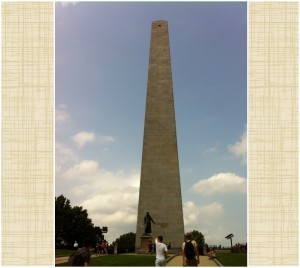
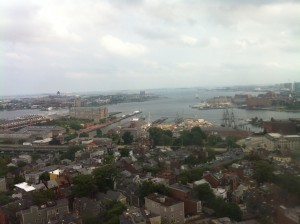
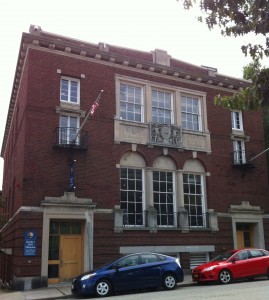
Down on the Charles River we come to the Charlestown Navy Yard, known as the Boston Navy Yard during World War II. The Navy Yard is the official home of the USS Constitution, the flagship of the United States Navy and the oldest commissioned warship in the world. Launched in Boston in 1797, the frigate earned her fame in the War of 1812, when she obtained the nickname “Old Ironsides” for how cannonballs bounced off her oaken hull.
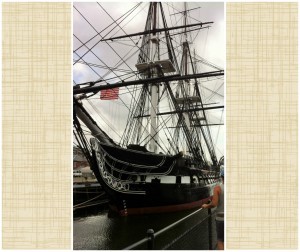
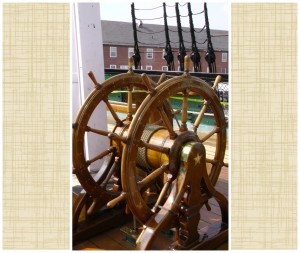
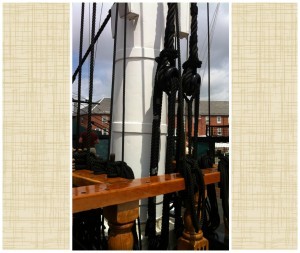
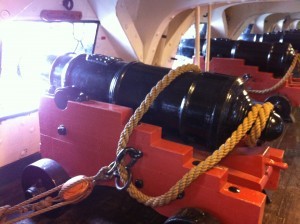
The Constitution undergoes periodic restorations. In 1925, schoolchildren were encouraged to donate their pennies to restore Old Ironsides, and my grandmother received this little button for her contribution. The USS Constitution Museum sells jewelry made from copper reclaimed in restoration projects, and I couldn’t resist this bracelet and earring set. The Constitution is currently in Dry Dock 1 for another restoration through 2017, but she’s still open for visitors.
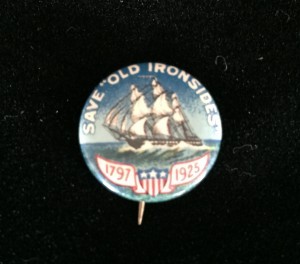
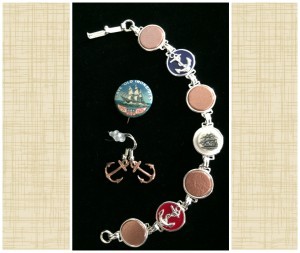
Sources:
Freedom Trail Foundation: http://www.thefreedomtrail.org/
National Historical Park, Massachusetts: http://www.nps.gov/bost/planyourvisit/index.htm
USS Constitution Museum: http://www.ussconstitutionmuseum.org/
Wikipedia: http://en.wikipedia.org/wiki/Freedom_Trail
Sammarco, Anthony Mitchell. Images of America: Charlestown. Charleston, SC: Arcadia Publishing, 1996.
Giveaway Winners
Thank you to everyone who entered the three-book giveaway for Through Waters Deep over the past week and a half! There were 321 entries on the blog, via email, and on Goodreads! Here are the three winners! I’ll notify the three of you by email.
Jenny Allbritain
Stella Gustafson
Samantha T. (with “pooh” email address)
Thanks again!
Today in World War II History—July 29, 1940 & 1945

Cruiser USS Indianapolis off Tinian, days before she was sunk, circa 26 Jul 1945 (US Naval History & Heritage Command)
75 Years Ago—July 29, 1940: Germany annexes Belgian provinces of Eupen, Malmédy, and Moresnet; bans speaking of French and Flemish.
70 Years Ago—July 29, 1945: After having delivered the atomic bomb to Tinian, cruiser USS Indianapolis is sunk by Japanese sub I-58 off Leyte, and is not missed for days. Only 316 of 1196 men will survive the shark-infested waters.
July 28, 2015
Today in World War II History—July 28, 1940 & 1945

Stalin, Attlee, Truman, and others at the Potsdam Conference, Germany, 28 Jul 1945 (German Federal Archive, Bild 183-R67561)
75 Years Ago—July 28, 1940: Road and rail links between Vichy and Nazi-occupied France are severed.
70 Years Ago—July 28, 1945: Japanese “choose to ignore” Potsdam Declaration requiring unconditional surrender. Destroyer USS Callaghan is sunk, the last Allied ship to be sunk by kamikaze. US Senate ratifies UN Charter. B-25 crashes into Empire State Building at 79th floor in fog; 19 killed.
July 27, 2015
Through Waters Deep – Tour of Boston, Part 3
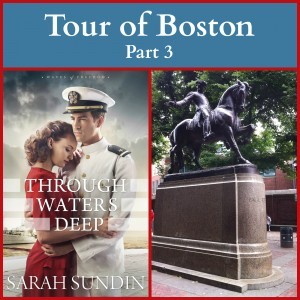 The city of Boston is fascinating—chockfull of history and color. While best known for its key role in the American Revolution, the city also played a role in World War II, with busy shipyards and naval bases—and more! The city’s reputation for revolutionary foment seemed a great backdrop for Through Waters Deep, set in the tumult of 1941, as isolationists and interventionists argued the correct course for the nation’s future, and as rumors of sabotage and espionage ran rampant.
The city of Boston is fascinating—chockfull of history and color. While best known for its key role in the American Revolution, the city also played a role in World War II, with busy shipyards and naval bases—and more! The city’s reputation for revolutionary foment seemed a great backdrop for Through Waters Deep, set in the tumult of 1941, as isolationists and interventionists argued the correct course for the nation’s future, and as rumors of sabotage and espionage ran rampant.
To enter the giveaway for Through Waters Deep, see the information at the end of the post.
I’ve been blessed to visit Boston a number of times. In July 2014, I made a research trip and took lots of pictures to help me visualize the story. We’ll follow the Freedom Trail, established in the 1950s to connect Boston’s multiple historical sites. Earlier we explored Boston Common and the Public Garden and Park Street Church. Later this week we’ll explore Charlestown and the USS Constitution, and the Charlestown Navy Yard.
Today we’ll visit Boston’s North End, starting at the Paul Revere House, built in 1680, the oldest structure in downtown Boston. The famous silversmith and engraver lived here from 1770-1800, and started his famous “Midnight Ride” here on April 18, 1775. The house was restored and opened as a popular tourist site in 1908.
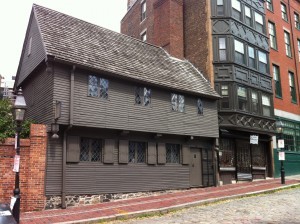
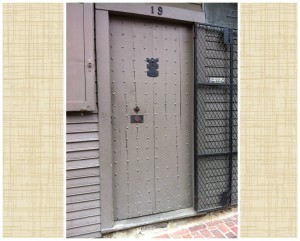
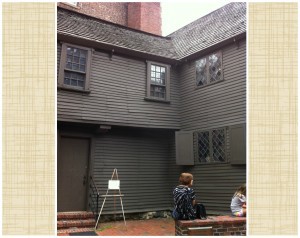
A short walk along the Freedom Trail, and we reach the Paul Revere Mall, built in 1933. This pleasant park leads to the Old North Church. The iconic statue of Paul Revere on his famous ride was erected here in 1940.
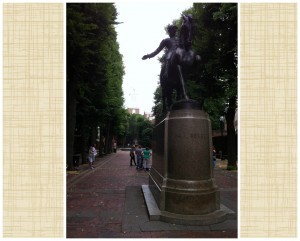
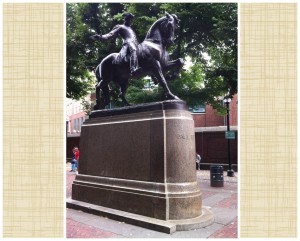
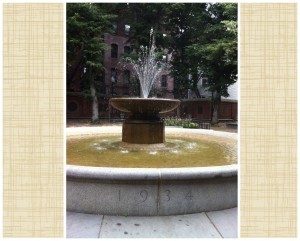
Christ Church, commonly called Old North Church, is Boston’s oldest standing church, built in 1723. Late at night on April 18, 1775, the sexton hung two lanterns in the tall steeple, warning patriots across the Charles River in Charlestown that the British soldiers were coming. In his famous poem “Paul Revere’s Ride,” Henry Wadsworth Longfellow recorded the signal, “One, if by land, and two, if by sea.”
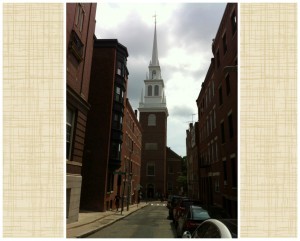
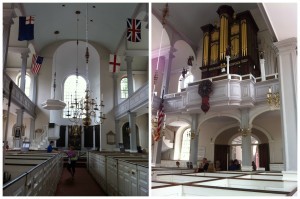
Sources:
Freedom Trail Foundation: http://www.thefreedomtrail.org/
National Historical Park, Massachusetts: http://www.nps.gov/bost/planyourvisit/index.htm
Wikipedia: http://en.wikipedia.org/wiki/Freedom_Trail
The Paul Revere House: https://www.paulreverehouse.org/
Old North Church: http://oldnorth.com/
Giveaway
This week I’m giving away THREE copies of Through Waters Deep! To enter, leave a comment below (US & Canada only please), on the video post, or on any of the Tour of Boston posts (Part 1, Part 2), which will show the sites featured in the novel. You can earn a maximum of four entries by leaving a comment on each of the four posts. If you can’t leave a comment, please send me an email to enter. Giveaway ends Monday, July 27, 2015 at midnight, Pacific Time. I’ll announce the winner here on Wednesday, July 29, 2015.
Today in World War II History—July 27, 1940 & 1945
 75 Years Ago—July 27, 1940: Bugs Bunny makes debut in A Wild Hare in an unnamed role; first uses “What’s up, Doc?”
75 Years Ago—July 27, 1940: Bugs Bunny makes debut in A Wild Hare in an unnamed role; first uses “What’s up, Doc?”
70 Years Ago—July 27, 1945: Chinese retake Kweilin from Japanese in southeast China.
July 26, 2015
Today in World War II History—July 26, 1940 & 1945
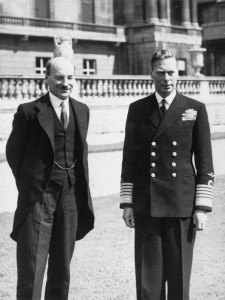
British Prime Minister Clement Attlee and King George VI of the United Kingdom, Buckingham Palace, London, England, 26 Jul 1945. (Imperial War Museum)
75 Years Ago—July 26, 1940: League of Nations is disbanded. US bans export of strategic materials (aviation fuel, iron, steel) to Japan. Movie premiere of Pride and Prejudice, starring Lawrence Olivier, Greer Garson.
70 Years Ago—July 26, 1945: Potsdam Declaration gives Japan ultimatum requiring unconditional surrender. Cruiser USS Indianapolis delivers “Little Boy” atomic bomb to Tinian. British parliamentary election results are announced; Prime Minister Winston Churchill resigns, replaced by Clement Attlee.
July 25, 2015
Today in World War II History—July 25, 1940 & 1945
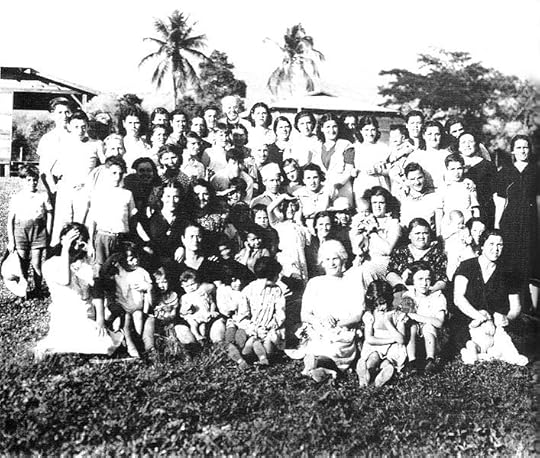
Civilians at the Gibraltar Evacuee Camp in Jamaica, WWII (United Kingdom government photo)
75 Years Ago—July 25, 1940: Women and children are evacuated from British territory of Gibraltar.
70 Years Ago—July 25, 1945: US secures Sarangani Bay on Mindanao in the Philippines.



